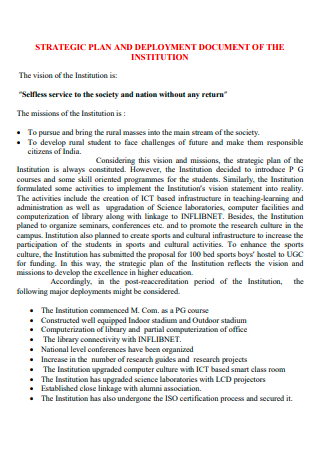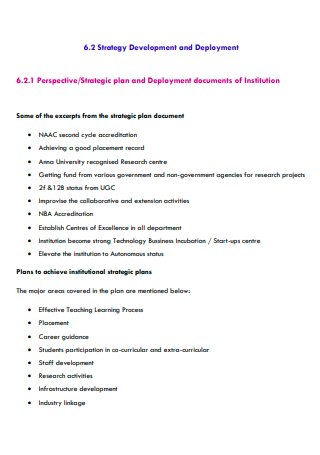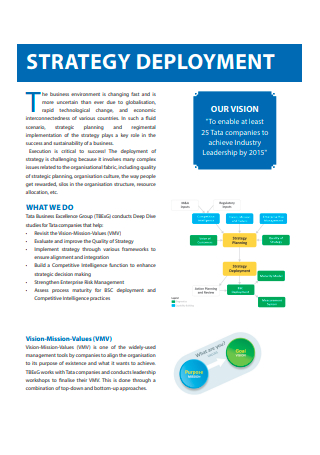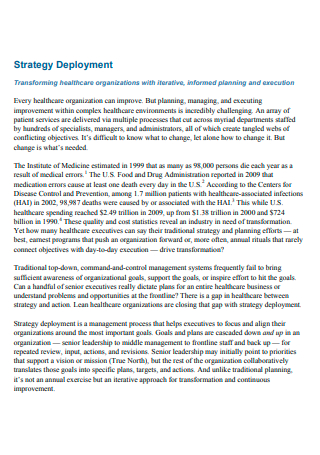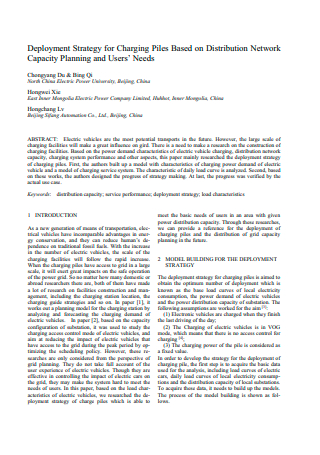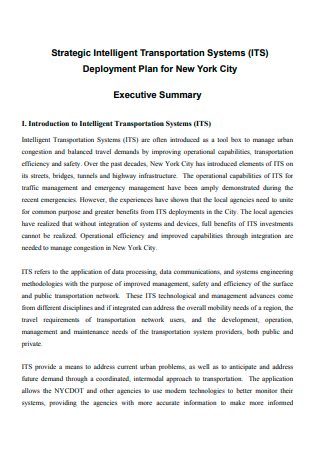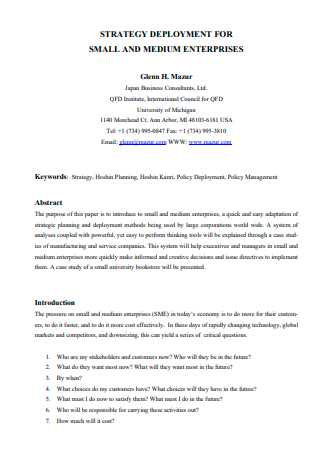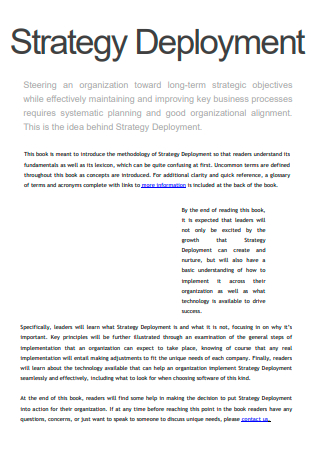8+ Sample Deployment Strategy Plan
FREE Deployment Strategy Plan s to Download
What Is a Deployment Strategy Plan?
When you work for a firm, you might produce a strategy and implementation plans that outline the specifics, strategies, and timetables for creating and implementing the company’s strategy. Strategy and implementation plans are documents that detail the specifics, techniques, and timelines for designing and implementing your organization’s strategies. In contrast, strategic plans are not industry-specific and can be utilized for various goals. Developing a strategic plan is the most effective first step toward beginning a business successfully, assuming you have a business concept that you intend to pursue and accomplish. Numerous studies have indicated that up to 67% of strategic planning is unsuccessful.
Benefits of Deployment Plans
Creating a deployment plan typically takes a considerable amount of work, but the benefits can be substantial. The following are a few crucial advantages of a deployment plan:
It conserves time: When staff comprehend the deployment plan and know what to do, they are less likely to install software incorrectly. This can save time since it eliminates the need to consider making modifications throughout the development process. Deployment plans can also save you time by outlining the most effective methods for implementing software.It provides enhanced security: When introducing the new software, you can increase security by giving permission roles to select employees and stakeholders. Permission roles enable users to do particular functions or actions, such as adding a new user to a database. A deployment plan may specify who can assign permission roles before, during, and following implementation. This procedure promotes a higher level of security by making it more difficult for unauthorized individuals to access the system.It monitors user conduct: During software deployment, user actions are frequently observed. Typically, the deployment plan describes how to collect user activity data. By monitoring and evaluating this data, you can confirm that the program is functioning correctly and that there are no operational problems.Significant Savings in Time: Developers may construct a timeline with deployment planning and identify the necessary deployment resources. This helps developers save time because the essential hardware, software, human resources, etc., for deployment are already in place. The processes required for a successful delivery can be scheduled appropriately with adequate planning. When developers arrange software releases, installation, testing, and performance monitoring, they will have the necessary resources and may prevent last-minute scrambling.No Dead-on-Arrival Releases: Do you wonder why some businesses lose customers when new products are shipped to consumers? It is because they do not send essential functionality. Every new product or service should increase the user base by maintaining existing users and attracting new ones. However, this objective will not be met if there are few returning or new customers following the launch of new products. With a deployment strategy in place, developers can evaluate product effectiveness and obtain user feedback. This will allow them to consider actual users the next time they ship a product.Better Organization, Review Company Projects: Deployment planning assists developers in knowing precisely what they are working on, what must be accomplished, and what has been accomplished. It allows them to reconsider the deployment plan if a problem arises. When organizations need a new developer, a better organization provides them with a competitive edge. This is because processes are appropriately documented.Risk Mitigation: Numerous hazards are associated with software deployments, such as crashes, unresponsive goods, and the shipment of items that do not bring value to users, etc. All of these dangers can be minimized by careful deployment preparation. When product developers add new functionality or deploy new goods, they must test them. Does the code function? Is the design pleasing? With the proper testing environment, developers can monitor the responsiveness and performance of their products. Developers need to arrange their deployments accordingly. Risks can be reduced to a bare minimum if all processes are executed with discretion. If the stakes are not minimized, they will incur costs in money, time, and other resources.
Elements of a Deployment Plan
It is essential to adhere to the strategic planning process and concentrate on the parts that comprise an effective strategic plan to reduce complications and reoccurring issues. Depending on the complexity of your planning process, the emphasis on strategic planning elements may shift slightly. Still, the following are some of the essential factors to consider while implementing your strategic plan. These components are necessary to comprehend the issue and the operating environment. By accounting for each of these factors, you assure the rest of your business that you have thoroughly investigated the case, taking any potential challenges or concerns into account.
Vision: The idea that your vision should be is how you want the rest of the world to perceive your firm. You should already have a vision statement unless you are just starting or seeking to rebrand. What image do you hope to convey to folks unfamiliar with your business? A solid vision statement should outline your company’s current and future ambitions. This should be utilized as a decision-making guide to ensure that your decisions align with the company’s goal. It is essential to highlight that a vision statement should be revised periodically. Like fashion, technology and values evolve, so your goals must adapt accordingly. It’s vital to make decisions based on your vision statement, but it’s also important to occasionally modify your vision statement to reflect those decisions.Mission: Like your vision, your business should have a mission that guides its actions. A mission statement extends beyond a vision statement’s basic description by elaborating on the company’s accomplishments. This is an excellent tool since it provides information about your organization to individuals outside of it. Every firm has a mission statement, which is frequently made public so that individuals unfamiliar with the organization can discover why it exists. If a mission statement is overly explicit, it might be restrictive for the organization that produced it. They may feel compelled to comply with the rigid boundaries they have set. Your mission statement should demonstrate who you are as a business and where you intend to go. It should be clear and straightforward, providing all corporate members with the necessary information to meet expectations. Like a vision statement, a mission statement can be updated and revised, but it should not be done in a rush since it will lose its power with customers.Short Term Goals: At this level, your objectives should align with your vision and mission statements. Now that you have a plan for what you desire to achieve as a firm, it’s time to determine which objectives your organization should pursue. It is essential to ensure that your strategic plan stays on track by following business-appropriate dreams. When contemplating objectives, it is necessary to keep in mind the following rules: Goals should be measurable, attainable, and have a specific communication channel—these recommendations aid organizations in establishing task-specific limits and accountability. Thus, plans do not become unduly ambitious while remaining sufficiently expansive to warrant innovation. Remember that these are only short-term objectives. They can strive towards a larger purpose, but their development should not continue.SWOT Analysis: A SWOT analysis is an essential device for any organization. As an organizational tool, a SWOT Analysis can provide valuable information about the actions of your firm and industry. The acronym SWOT represents strengths, weaknesses, opportunities, and threats. Every business has distinctive strengths and weaknesses that allow it to advance or fall behind in its field. Similarly, opportunities and dangers are external factors that exist in a company’s industry. By examining your firm’s internal and external influences, you can determine where and where not to allocate resources. This is a helpful tool for evaluating your goals. By displaying all variables on a single graph, we can decide which optimal options to choose.Long Term Goals and Objectives: Long-term goals may be the first thing that comes to mind when making a strategic plan since they are some of the biggest problems you may want to solve, but they may be harder to come up with than you think. Long-term goals are also broader and will take more time to achieve. These goals should have a time frame of a few years from when they were first made. Long-term goals should follow the same rules as short-term goals: they should be measurable, realistic, and easy to talk about. Since these goals take longer to reach, it’s even more critical that they stay on track. One way to achieve your long-term goals is to set yearly goals. Your yearly goals are shorter-term goals that help you achieve your long-term goal as a whole. These can be short-term goals, but what makes them different is that they help you reach your long-term goal. By setting short-term goals, you can gain momentum and see the results of your progress in a shorter amount of time. Losing interest is the thing that makes long-term goals the most discouraging. These yearly goals can be just what everyone needs to stay motivated and interested.
How To Write a Deployment Strategy Plan
Typically, the deployment strategy is drafted by the project manager. However, the creation of the plan may benefit from the contributions of the entire team. The steps involved in writing a deployment plan are outlined below.
1. Summarize your deployment goals
Start by having a clear idea of how the deployment will go. You will need to know when and where you plan to launch your product. It would help to let people know what effect your deployment will have. Impact includes how it will affect your staff and resources and how you think it will help your user community. This first summary enables you to define the scope of your work and decide how long your project will take.
2. Document and mitigate hazards
List any potential dangers that could impede a deployment’s success. For instance, not having adequate support from people ready to run the help desk when your new product starts could be dangerous. Next, assign a chance to each risk and assess its potential impact on deployment. In the last case, insufficient support for employees could have significantly influenced end-user satisfaction. Since your takeoff is in the summer, it is relatively high when many employees are on vacation. Finally, provide a list of risk mitigation measures. In our example, you may request office attendance during your launch week. As you will be considering deployment plans in this initial planning phase and throughout the project development lifecycle, you may encounter hazards that you did not anticipate as you go into product design or testing. Using project management software, you can write comments for your team when discovering new dangers.
3. Create a deployment schedule
A deployment schedule divides the production deployment process into manageable activities that can be delegated to particular team members. Each job should have a designated assignee and beginning and ending dates. Among your responsibilities may be implementing the software update on your website, monitoring the help desk for user inquiries, and providing fast responses.
4. Make a list of the requirements for deployment.
Determine early on the necessary resources for a successful rollout. These include computer hardware, routers, phones, and office space. Software resources may consist of platforms for project management, help desk applications, and customer management databases. Consideration should also be given to the time required to implement and monitor the deployment plan. You can ensure a smoother launch without scrambling for equipment or team support by addressing these beforehand.
5. Establish a communication plan for deployment
Clear communication is essential for deployment success. Determine who must connect with whom, how frequently, and through what means. For instance, your lead software developer and project manager may conduct a weekly conference call to assess operational readiness. A deployment communication plan may also contain common resources that enhance uniformity in the team’s approach to deployment. When delivering a new program feature to clients, a software deployment checklist could include specific metrics that staff members must monitor and record regularly, such as page loading speed.
FAQs
What is a plan for setting up a system?
The System Deployment Strategy is an all-encompassing implementation plan that considers the people, procedures, and technology that must be in place for the system to be effectively implemented, adopted by the user community, and for its advantages to be realized.
What is a deployment report?
Reports on deployments include historical data, such as the total number of deployment runs and the average time of those operations. Pick the date range and application filters at the top of the report to run a deployment report, then click Run.
How many days of leave are granted following a deployment?
If you work for the federal government in a civilian capacity, you may be eligible for 22 days of military exigency leave from your federal civilian post. Under certain conditions, National Guard and Reserve technicians are qualified for 44 days of military withdrawal from their technician post for overseas duty.
Having a written plan for deployment keeps you from missing important things at every step. The best way to plan for a deployment is to make a list and check things off as you finish them. Making sure everyone on the team is on the same page is just as important. Effectively talk to each team member. The bottom line? Planning for deployment is a must to avoid surprises and delays.
